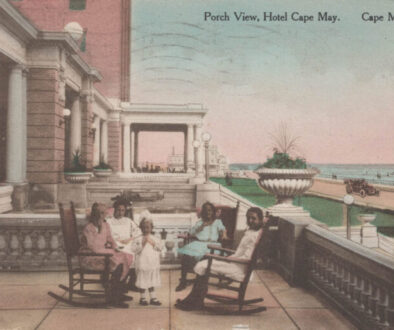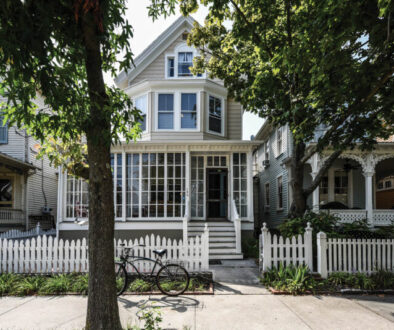The Transformation of 1069: Prelude

Since its construction amid the grasses and phragmites on Michigan Avenue in 1957, a total of six owners have been recorded on the deeds to 1069 Michigan Avenue. It was known as the LaMonica house for the last half of the 20th century. And for good reason. Peter LaMonica had the house built after he acquired the property in 1956. Mr. LaMonica is described by his descendants in glowing terms. He was bright, ambitious, fun-loving, and a true family man. Mary LaMonica, his wife, having lived in an apartment over a fish market in Brooklyn, had a dream of living in a grand home with her husband and four children. Peter set out to fulfill her dream—and his—in Cape May.
LaMonica had heard that conch (sea snails used for making scungilli) were quite plentiful in Cape May. That was enough for Peter and one of his sons to investigate, which shortly led to establishing a new business, Cape May Canners. As they were ramping up, conch became less plentiful; however, surf clams were numerous and rising in popularity nationwide. When he changed his focus to clams, the business grew rapidly to become the only hand-shucked clam source in South Jersey; it is still the largest in the industry.

As Cape May Canners [Foods] prospered and his confidence grew, Mr. LaMonica contracted Curcio Builders to create a California Ranch house, hoping to satisfy Mary’s dream and become the “grandest home” in Cape May. They broke ground when Michigan Avenue had only a few lots drawn up for building across from empty wetlands. Behind the property and the phragmites, the remnants of the Physick House deteriorated on the open land.
When it was finished, the house they built was like a fortress. The foundation was a deep chambered concrete block base. Tennessee Marble graced the entire front façade and patio walls. Not truly marble, the pink crystalline limestone at that time was used in many significant historic buildings. Whatever wasn’t Tennessee Marble on the exterior was white brick.
Inside, the new house boasted everything a modern dwelling of the late 1950s would be expected to have, and more. The overall interior was classic art deco. The floors were light, unstained polished hardwood. There was a sunken living room that had a grand fireplace, complete with floating hearth, made from Porturo black marble, delivered direct from Italy. The kitchen counter had a built-in motorized spindle that could drive a blender, sharpener, juicer, mixer, and meat grinder. Recessed into the backsplashes, chrome-trimmed steel holders kept paper towels, wax paper/tin foil, and spices hidden from view. The 1950s heralded the arrival of the electric kitchen. In the LaMonica house, there was a large Frigidaire refrigerator. The oven and range were electric, and a place for a dishwasher was set to be filled when it became available.
Off the master bedroom, the pink ceramic tile-trimmed bathroom was mixed with faux black marble Formica. Next to a built-in linen closet and hamper, there was an enormous mirrored medicine cabinet, and adjacent to the commode was a recessed magazine rack with a holder for toilet tissue. The angled makeup vanity was built in next to the sink that had polished chrome faucets. The enclosed tub occupied a square base that was nearly five feet on a side and had spa-like multiple shower heads. Above the tub entry was a heavy chrome and steel decorative bar that held the glass tub enclosure. It was extraordinary.
All told there were four bedrooms, two full baths, and two powder rooms. Two of the bedrooms and a powder room were engineered into a second floor. Every wall in the house was lathe with at least two coats of plaster.
In the center of the house, Mr. LaMonica built a den lined with oak panels and illuminated with cove lighting. It was outfitted with a wet bar and a pair of recliners. The den opened to a large flagstone screened-in patio which was covered with a pink vermiculite ceiling. Outside, in the corner of the yard he added a concrete block barbeque complete with a chimney.
In addition to the overall footprint of the house was an oversized two-car attached garage, equipped with a ceramic tiled shower in one corner. The extra-wide garage door opened to an extensive concrete driveway, with a retaining wall on one side and more Tennessee Marble on the facings of the steps that led to the laundry area inside.
In Cape May, the LaMonica house was a showplace like no other in 1957. Mary LaMonica enjoyed many years with her family there before her death in 1977, predeceasing her husband by more than a year. According to the deed, the LaMonica estate sold the house in 1981 to a Pennsylvania corporation. It changed resident owners three times thereafter and was altered substantially, particularly inside. It was put on the market most recently in June 2017, 60 years after it was built for Mary and Peter LaMonica.


Winter, 2018
Elaine Stevenson started looking to buy a new domicile for herself in Cape May sometime after her husband passed away. Together they had owned a property near Morristown, New Jersey, and a summer home in Cold Spring. Her intention was to buy a property to replace both houses and move permanently to Cape May. She had been investigating properties in Cape May through the internet for two years when she came upon 1069 Michigan Avenue.
The listing had been on the market for 18 months by the time it came across her radar. At one time the property had a seven-figure listing price. The online preview had several photos that Elaine found a bit startling; but the exterior –an appealing summertime scene—got her attention. It was a “ranch with character” in Cape May. Elaine called the agent, Charity Clark, and they set up an appointment for a showing.
It was Elaine’s last stop on a December day that had been filled with appointments… and disappointments. She sat quietly in her car for a few minutes taking it all in. The Tennessee Marble stone was much pinker than she expected, and the flagstone front patio showed a lot of wear. As she looked around, she could see the house had the bones of a California Ranch; but a pair of windows that looked out over the garage indicated a second floor was likely nested in the eaves of the large hip roof. The garage and the side walls were white brick. She thought they may have been painted. Were they actually white bricks?


Charity opened the front door to give Elaine her first look inside. From Elaine’s experience with other houses, she knew well that whenever visiting a house for sale, the furnishings and embellishments should be ignored. Nevertheless, because they populated every room, the large collections of well-kept antiques, art, house plants, and ornate furnishings were not easy to overlook.
The big open foyer gave Elaine pause. She loved the feel of the entrance. It was welcoming and reminiscent of houses that impressed her as a child. But there was an unusual marble fountain embedded in one wall. The dining room on the left and the living room on the right were as startling as the internet pictures had depicted.
The floors in the foyer and hallways were covered with gold and gray marble, overlayed with oriental carpets. The entrance to the living room had a pair of marble railings that narrowed the access to the two-step drop onto the Carrera marble floor. More Carrera covered the dining room floor, again adorned with oriental carpets.
Unlike the foyer, the dining room walls were dark with carved paneling that stretched floor to ceiling. Built into one wall was a sculpture of the Last Supper. In the living room more ornately carved dark panels went up the walls and continued at an angle across the ceiling, reaching a peak at the center where the two walls met. The panels, she learned later, came from a chapel somewhere in Cape May County and were fitted to the room. At the far end was a large black marble wood-burning fireplace above which was fastened a huge cross-hatched beveled mirror. The only natural light in the room came through a bay window composed of 32 small glass panels, a row of which could be opened for ventilation.
The whole scene was very different from any house she had been in. It seemed almost church-like.
Beyond the foyer was a pair of arched doors that opened to another dark room. This was the library, lined with bulging bookcases mounted onto the walls. The natural light in this room came only from windows that looked into the Florida room on the far wall.
Charity led her to the brightly lit galley kitchen. The wall cabinets and the Formica countertops were originally from Keystone Kitchens and installed by Sabers in Atlantic City. They had been the “top of the line” in the 1950s. A pair of bar stools were at the end of the counter. A glass sliding door, set at an arbitrary angle, led to the Florida Room, essentially an enclosed porch with a flagstone floor and a pair of skylights.


Charity showed her the large master bedroom with its elaborate Art Deco bath. They went down a hallway and turned to go up the steps. A powder room and a pair of bedrooms were at the top of the stairs. The prefinished hardwood floors matched the railings and steps.
They checked the garage and the utilities. The water heater and the furnace were aging. So, too, was the tile shower in the garage. It didn’t work.
Outside, the retaining wall appeared to be weakening. There was a chain-link fence all around three sides of the lot with a withering stockade fence in front of it, along the back. Overgrown Pyracantha grew up the fence, blocking any view of the back. Because of the overgrown evergreens, Elaine couldn’t see either the tennis courts or any of the Physick Estate buildings, but she knew they were there.
When the showing was over, Elaine told Charity she would give it some serious thought, though the price was not right. She reflected on what she’d seen as she drove home. There were things that weren’t to her liking for sure. The house was warm and apparently dry; yet she was bothered by a musty smell in certain rooms.
She started to feel that she may have found the right house, but she certainly couldn’t live there permanently as it was. She would have to do some very substantial alterations to make it what she wanted. Whatever she paid the owners would be the base onto which the cost of improvements would be added. Although her enthusiasm at finding a real possibility for her new home in Cape May was tempered by what she saw on the first visit, she wasn’t ready to flatly reject the house.


The price was reduced soon after Elaine’s visit, but she continued to look at other properties. No luck. Just before Christmas, she called Charity and arranged for another visit to Michigan Avenue, this time with a measuring tape, a notebook, and a friend who had a hard time seeing past the accoutrements. When he bumped his head on the ceiling at the top of the steps he muttered, “Are you sure about this?”
Elaine saw things the second time that she had not noticed earlier. The hallways were taking up space and made her feel almost claustrophobic. The flagstone was in poor shape in both the front and the back. There was no room for the pool that she wanted unless the Florida room and the garage were removed. And the whole house wasn’t as warm as she remembered from her first visit.
Still, she took her measurements home and drafted a floor plan using a design program on her computer. As she started to imagine the house in different ways, she found herself becoming intrigued.


When the contractor’s ballpark estimate came in, Elaine returned to her computer drawings and started to explore the possibilities. She conferred with experts that she knew from her previous experiences; she called friends for advice; she scoured the internet for comparable projects. And then she called Charity about making an offer.
They arrived at a price they thought would be okay without offending the owners. When it was refused, Elaine had to reconsider some of the costs she had penciled in with her contractor and over the next couple of weeks decided she could raise her offer. In the interim, the husband of the couple who owned the house, a man whose godfather had been Baron Von Trappe (of Sound of Music fame), passed away. Everything had to stop for a while.
In early March, Elaine and Charity tried again to seal the deal. They set what they deemed a doable price and after some give and take, they had an agreement. It also allowed the widow time to gather her many treasured belongings and to make arrangements for a new place to live.




As with most agreements of sale, this one was contingent on a home inspection that was set up quickly. The inspector crawled under the floors and around the eaves; he tested plumbing and electrical circuits, inspected heating and air conditioning systems, and looked for infestations. His 25-page report was full of recommendations for everything from insulation removal and replacement, fixing step cracks in the masonry to replacing a fireproof door. There were quite a few must-dos and many more should-dos. He recommended that extensive evaluations by individual contractors be done to check flaws, but he saw nothing that would stop the contract cold. Elaine agreed to covering most of the repairs; the owner picked up the costs of others.
Still, there were flashing yellow lights that went unnoticed.
Settlement was made on March 29, 2019, and the rights to the property were turned over. By agreement, the owner remained in 1069 Michigan until the end of June. Once vacated, the true size and scope of the project began to emerge…



